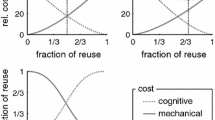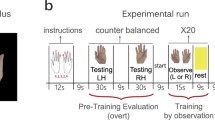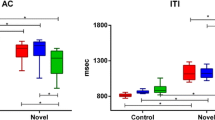Abstract
We investigated the modulation of cerebellar activation by predictive and non-predictive sequential finger movements. It is hypothesized that the prediction of desired movement sequences and adaptation to new movement parameters is mediated by the cerebellum. Using functional MRI at 1.5T, seven normal subjects performed sequential finger to thumb opposition movements, either in predictive (repeatedly 2,3,4,5) or non-predictive (randomized) fashion at a constant frequency of 1 Hz. Performance and error rates were monitored by simultaneous recording of the finger movements. Predictive sequential finger opposition movements activated a cerebellar network including the lobuli IV–VI ipsilateral to the movements, the contralateral lobuli IV–VI, the vermis, and lobuli VIIB–VIII ipsilaterally. Non-predictive compared to predictive finger opposition movements activated a broader area within the ipsi- and contralateral anterior cerebellum, lobuli IV–VI, the vermis, and the ipsilateral lobuli VIIB–VIII. Additional activation foci were found in the contralateral lobuli VIIA and VIIB–VIII. Our study demonstrates a modulated information processing within the cerebellar network dependent on the predictability of movement sequences.
Similar content being viewed by others
References
Kawato M. Internal models for motor control and trajectory planning. Curr Opin Neurobiol 1999; 9: 718–727.
Ito M. Neurobiology: internal model visualised. Nature 2000; 403: 153–154.
Fox PT, Fox JM, Raichle ME, Burde RM. The role of cerebral cortex in the generation of voluntary saccades: a positron emission tomography study. J Neurophysiol 1985; 54: 348–369.
Grafton ST, Woods RP, Mazziotta JC. Within-arm somatotopy in human motor areas determined by positron emission tomography imaging of cerebral blood flow. Exp Brain Res 1993; 95: 172–176.
Ellermann JM, Flament D, Kim SG, et al. Spatial patterns of functional activation of the cerebellum investigated using high field (4T) MRI. NMR Biomed 1994; 7: 63–68.
Nitschke MF, Kleinschmidt A, Wessel K, Frahm J. Somatotopic motor representation in the human anterior cerebellum. A high resolution functional MRI study. Brain 1996; 119: 1023–1029.
Lotze M, Montoya P, Erb M, et al. Activation of cortical and cerebellar motor areas during executed and imagined hand movements: an fMRI study. J Cogn Neurosci 1999; 11: 491–501.
Desmond JE, Gabrieli JD, Wagner AD, Ginier BL, Glover GH. Lobular patterns of cerebellar activation in verbal working-memory and finger-tapping tasks as revealed by functional MRI. J Neurosci 1997; 17: 9675–9685.
Ellermann JM, Siegal JD, Strupp JP, Ebner TJ, Ugurbil K. Activation of visuomotor systems during visually guided movements: a functional MRI study. J Magn Reson 1998; 131: 272–285.
Nitschke MF, Hahn C, Melchert UH, Handels H, Wessel K. Activation of the human anterior cerebellum by finger movements and sensory finger stimulation: a functional magnetic resonance imaging study. J Neuroimaging 1998; 8: 127–131.
Luft AR, Skalej M, Stefanou A, Klose U, Voigt K. Comparing motionand imagery-related activation in the human cerebellum: a functional MRI study. Hum Brain Mapp 1998; 6: 105–113.
Grodd W, Hülsmann E, Lotze M, Wildgruber D, Erb M. Sensorimotor mapping of the human cerebellum: fMRI evidence of somatotopic organization. Hum Brain Mapp 2001; 13: 55–71.
Middleton FA, Strick PL. Cerebellar projections to the prefrontal cortex of the primate. J Neurosci 2001; 21: 700–712.
Sadato N, Campbell G, Ibanez V, Deiber MP, Hallett M. Complexity affects regional cerebral blood flow change during sequential finger movements. J Neurosci 1996; 16: 2693–2700.
Catalan MJ, Honda M, Weeks RA, Cohen LG, Hallett M. The functional neuroanatomy of simple and complex sequential finger movements: a PET study. Brain 1998; 121: 253–264.
Cui SZ, Li EZ, Zang YF, Weng XC, Ivry R, Wang JJ. Both sides of human cerebellum involved in preparation and execution of sequential movements. Neuroreport 2000; 11: 3849–3853.
Friston KJ, Holmes AP, Worsley KJ, Poline J-B, Frith CD, Frackowiak RSJ. Statistical parametric maps in functional imaging: a general linear approach. Hum Brain Mapp 1995; 2: 189–210.
Friston KJ, Ashbumer J, Poline JB, Frith CD, Heather JD, Frackowiak RSJ. Spatial realignment and normalization of images. Hum Brain Mapp 1997; 2: 165–189.
Schmahmann JD, Doyon J, McDonald D, et al. Three-dimensional MRI atlas of the human cerebellum in proportional stereotaxic space. Neuroimage 1999; 10: 233–260.
Talairach J, Tournoux P. Co-planar Stereotaxic Atlas of the Human Brain. Thieme, Stuttgart, 1988.
Dreher JC, Grafman J. The roles of the cerebellum and basal ganglia in timing and error prediction. Eur J Neurosci 2002; 16: 1609–1619.
Snider RS, Eldred E. Cerebro-cerebellar relationships in the monkey. J Neurophysiol 1952; 15: 27–40.
Voogd J, Glickstein M. The anatomy of the cerebellum. Trends Neurosci 1998; 21: 370–375.
Ekerot CF, Larson B. Branching of olivary axons to innervate pairs of sagittal zones in the cerebellar anterior lobe of the cat. Exp Brain Res 1982; 48: 185–198.
Miles TS, Wiesendanger M. Organization of climbing fibre projections to the cerebellar cortex from trigeminal cutaneous afferents and from the SI face area of the cerebral cortex in the cat. J Physiol (Lond) 1975; 245: 409–424.
Kassel J, Shambes GM, Welker W. Fractured cutaneous projections to the granule cell layer of the posterior cerebellar hemisphere of the domestic cat. J Comp Neurol 1984; 225: 458–468.
Shambes GM, Gibson JM, Welker WI. Fractured somatotopy in granular cell tactile areas in rat cerebellar hemispheres revealed by micromapping. Brain Behav Evol 1987; 15: 94–140.
Thach WT. On the specific role of the cerebellum in motor learning and cognition: clues from PET activation and lesion studies in man. Behav Brain Sci 1996; 19: 411–431.
Roland PE. Metabolic mapping of sensorimotor integration in the human brain. In: Bock G, O’Connor M, Marsh J. editors. Motor Areas of the Cerebral Cortex (Ciba Foundation Symposium 132). New York: Wiley, 1987.
Seitz RJ, Canavan AGM, Yàgüez L, et al. Successive roles of the cerebellum and the cortex in trajectorial learning. Neuroreport 1994; 5: 2541–2544.
Flament D, Ellermann J, Kim SG, Ugurbil K, Ebner T. Functional magnetic resonance imaging of cerebellar activation during learning of a visuomotor dissociation task. Hum Brain Mapp 1996; 4: 210–226.
Toni I, Krams M, Turner R, Passingham RE. The time course of changes during motor sequence learning. A whole brain fMRI study. Neuroimage 1998; 8: 50–61.
Imamizu H, Miyauchi S, Tamada T, et al. Human cerebellar activity reflecting an acquired internal model of a new tool. Nature 2000; 403: 192–195.
Ivry R. Exploring the role of the cerebellum in sensory anticipation and timing: commentary on Tesche and Karhu. Hum Brain Mapp 2000; 9: 115–118.
Thier P, Dicke PW, Haas R, Barash S. Encoding of movement time by populations of cerebellar Purkinje cells. Nature 2000; 405: 72–76.
Braitenberg V, Heck D, Sultan F. The detection and generation of sequences as a key to cerebellar function: experiments and theory. Bev Brain Sci 1997; 20: 229–277.
Kawashima R, Okuda J, Umetsu A, et al. Human cerebellum plays an important role in memory-timed finger movement: an fMRI study. J Neurophysiol 2000; 83: 1079–1087.
Juptner M, Rijntjes M, Weiller C, et al. Localization of a cerebellar timing process using PET. Neurology 1996; 47: 306–307.
Tracy JI, Faro SH, Mohamed FB, Pinsk M, Pinus A. Functional localization of a ‘time keeper’ function separate from attentional resources and task strategy. Neuroimage 2000; 11: 228–242.
Lutz K, Specht K, Shah NJ, Jancke L. Tapping movements according to regular and irregular visual timing signals investigated with fMRI. Neuroreport 2000; 11: 1301–1306.
Glickstein M. How are visual areas of the brain connected to motor areas for the sensory guidance of movement? Trends Neurosci 2000; 23: 613–617.
Brodai P, Bjaalie JG. Organization of the pontine nuclei. Neuroscience Res 1992; 13: 83–118.
Sakai K, Takino R, Hikosaka O, et al. Separate cerebellar areas for motor control. Neuroreport 1998; 13: 2359–2363.
Miall RC, Imamizu H, Miyauchi S. Activation of the cerebellum in co-ordinated eye and hand tracking movements: an fMRI study. Exp Brain Res 2000; 135: 22–33.
Allen G, Buxton RB, Wong EC, Courchesne E. Attentional activation of the cerebellum independent of motor involvement. Science 1997; 275: 1940–1943.
Indovina I, Sanes JN. Combined visual attention and finger movement effects on human brain representations. Exp Brain Res 2001; 140: 265–279.
Le TH, Pardo JV, Hu X. 4 T-fMRI study of nonspatial shifting of selective attention: cerebellar and parietal contributions. J Neurophysiol 1998; 79: 1535–1548.
Bischoff-Grethe A, Ivry RB, Grafton ST. Cerebellar involvement in response reassignment rather than attention. J Neurosci 2002; 22: 546–553.
Boecker H, Kleinschmidt A, Weindl A, Conrad B, Hänicke W, Frahm J. Dysfunctional activation of subcortical nuclei in palatal myoclonus detected by high-resolution MRI. NMR Biomed 1994; 7: 327–329.
Nitschke MF, Krüger G, Bruhn H, et al. Voluntary palatal tremor is associated with hyperactivation of the inferior olive—a fMRI study. Mov Disord 2001; 16: 1193–1195.
Kim SG, Ugurbil K, Strick PL. Activation of a cerebellar output nucleus during cognitive processing. Science 1994; 265: 949–951.
Author information
Authors and Affiliations
Corresponding author
Rights and permissions
About this article
Cite this article
Nitschke, M.F., Stavrou, G., Melchert, U.H. et al. Modulation of cerebellar activation by predictive and non-predictive sequential finger movements. Cerebellum 2, 233–240 (2003). https://doi.org/10.1080/14734220310005701
Received:
Revised:
Accepted:
Issue Date:
DOI: https://doi.org/10.1080/14734220310005701




